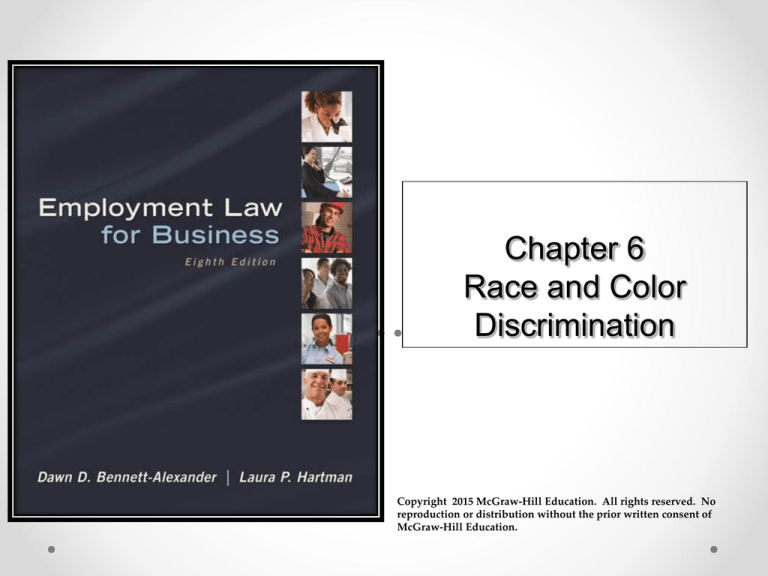
Chapter 6
Race and Color
Discrimination
Copyright 2015 McGraw-Hill Education. All rights reserved. No
reproduction or distribution without the prior written consent of
McGraw-Hill Education.
Learning Objectives (1)
Understand the long and deep history of race
discrimination and civil the rights movement in
the United States
Explain the relevance of the racial civil rights
struggle to present-day workplace race
discrimination issues
Explain why national origin issues have recently
been included under race discrimination claims
by the EEOC
6-2
Learning Objectives (2)
Understand that racial harassment is a particular
form of race discrimination; be able to apply its
prima facie case elements to relevant situations
Understand the ways in which ‘color’ is different
from ‘race’
Describe ways in which an employer can avoid
potential liability for race and color discrimination
6-3
Introduction
Race is the first of the prohibited categories in
Title VII
A 2008 USA Today/Gallup poll found
51 percent of whites, 59 percent of Hispanics, and 78
percent of blacks thought that racism against blacks
is widespread
Race discrimination claims continue to account
for one-third of total claims filed with EEOC
6-4
Evolving Definitions of Race
With regard to Title VII, ‘race’ has been almost
exclusively about African-Americans and whites
Discrimination against other groups considered
primarily under the ‘national origin’ category
Race vs. national origin
6-5
EEOC’s Revised Race/National Origin
Guidance
New forms of discrimination are emerging as
workforce demographics evolve
Issue of race discrimination in America is
multidimensional
EEOC receives race and color discrimination charges
alleging multiple or intersecting prohibited bases such
as age, disability, gender, national origin, and religion
Case: Alonzo v. Chase Manhattan Bank, N.A.
6-6
EEOC’s E-RACE Initiative
Why Do We Need E-RACE?
http://www.eeoc.gov/eeoc/initiatives/e-race/
Most frequently filed claims with the EEOC are issues
related to race
E-RACE Goals
http://www.eeoc.gov/eeoc/initiatives/e-race/goals.cfm
Improve data management, charge processing consistency and
respond to emerging issues of race and color in the workplace
Enhance visibility of EEOC efforts
Encourage voluntary initiatives to eradicate race and color
discrimination
Color discrimination claims are on the rise
6-7
EEOC’s Revised Race Guidance
Title VII’s prohibition encompasses
Ancestry
Physical characteristics
Race-linked illness
Culture and perception
Association
Subgroup or ‘race plus’
‘Reverse’ race discrimination against Caucasians
6-8
EEOC’s National Origin Guidance
Employment Decisions
Harassment
Accent discrimination
English fluency and English-only rules
Coverage of foreign nationals
Discrimination against individual is prohibited
regardless of citizenship
6-9
Present-day Race Issues
The “new racism” (belief that it’s been ‘solved’)
Study of intentional workplace discrimination
released by Alfred and Ruth Blumrosen in 2002
15 percent of African-Americans experience
intentional workplace discrimination
Eastman Kodak Co. – proactive pay raises
Awareness and knowledge of past history are
key
6-10
Background of Racial Discrimination in
the U.S.
The long history of racial discrimination has
present-day effects
Slavery lasted for over 200 years until after the
Civil War ended in 1865
After Reconstruction Slave Codes were simply
renamed “Black Codes”
Jim Crow laws
Legalized and codified racial discrimination
6-11
Background of Racial Discrimination in
the U.S.
Segregated public schools were outlawed by the
U.S. Supreme Court in Brown v. Board of
Education in 1954
Blacks were not admitted into many schools until
much later
Much continuing racial separation is de facto, not
based on law
Civil Rights Acts of 1964
Voting Rights Act of 1965
6-12
Race: Putting It All Together
U.S. Department of Labor Glass Ceiling Studies
in 1991 and 1995
“Glass ceiling” exists beyond which minorities rarely
progress
An employer must analyze and monitor
workplace information based on “glass ceiling”
considerations
Race discrimination can be discovered and
addressed before it progresses to litigation
6-13
General Considerations
Title VII was enacted primarily in response to
discrimination against blacks in the country, but
the act applies equally to all
Race discrimination against any group is equally
prohibited under Title VII
McDonald v. Santa Fe Transportation
6-14
Recognizing Race Discrimination
The latest EEOC statistics for FY 2010
35.890 percent of the total charges were based on
race
Employers often unable to recognize behaviors
that may be interpreted as race discrimination
6-15
Recognizing Race Discrimination
‘Garden variety’ racism still exists
Case: Jones v. Horseshoe Casino and Hotel
Unusual manifestations of race discrimination
Vaughn v. Edel, Scenario 2
Bradley v. Pizzaco of Nebraska, Inc., d/b/a Domino’s
Pizza, Scenario 3
Opposition activity is covered by Title 7
Case: Chandler v. Fast Lane, Inc.
6-16
Racial Harassment
A particular form of race discrimination
Prima facie case: to hold an employer liable for
racial harassment, the employee must show that
the harassment was:
Unwelcome
Based on race
So severe or pervasive that it altered the conditions of
employment and created an abusive environment
There is a basis for imposing liability on the employer
6-17
A Word About Color
Color is one of the five categories included in
Title VII as a prohibited basis for discrimination.
Color has been a divisive issue for as long as
African-Americans have been in the U.S.
Color discrimination can exist among people of
the same race
Color still matters a great deal in the workplace
6-18
Management Tips (2)
Take reports of racial discrimination from
employees seriously
Decisive corrective action may avoid liability.
HR matters.
Recognize and resolve simple
misunderstandings
Offer support groups, if needed
6-19
Management Tips (3)
Offer training in racial awareness and sensitivity
Constantly monitor workplace hiring,
termination, training, promotion, raises, and
discipline to ensure fairness
6-20





